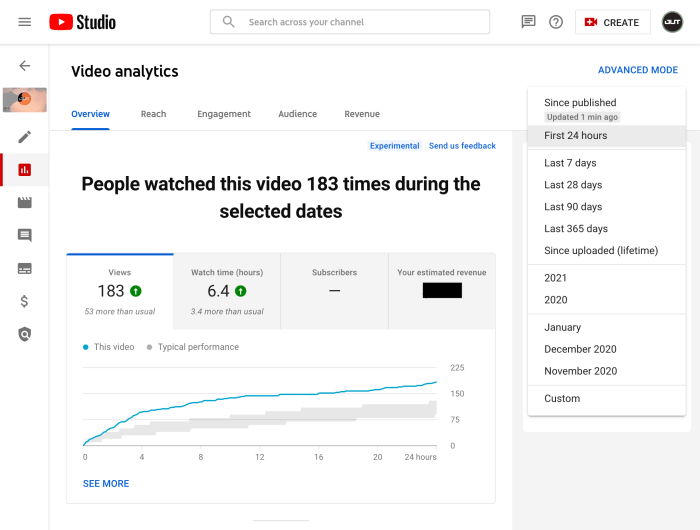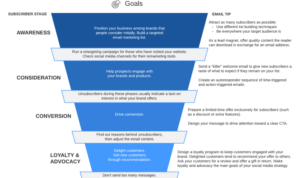Using YouTube Analytics sets the stage for this enthralling narrative, offering readers a glimpse into a story that is rich in detail with american high school hip style and brimming with originality from the outset.
YouTube Analytics provides a wealth of data and insights that can revolutionize the way content creators approach their channels, leading to improved strategies and audience engagement.
Overview of YouTube Analytics

YouTube Analytics is a powerful tool provided by YouTube for content creators to track and analyze the performance of their videos. It offers valuable insights into audience demographics, viewing behavior, engagement metrics, and more, helping creators make data-driven decisions to optimize their content and channel.
Key Features of YouTube Analytics
- Real-time data on video views, watch time, and engagement metrics.
- Demographic information about viewers, including age, gender, and location.
- Playback locations, traffic sources, and devices used to access the content.
- Retention metrics to understand how long viewers are watching the videos.
- Engagement data like likes, comments, shares, and subscriber activity.
Benefits of Using YouTube Analytics for Content Creators
- Insights to understand the audience better and tailor content to their preferences.
- Identifying trends and patterns to create more engaging and relevant videos.
- Optimizing video titles, descriptions, and thumbnails based on performance data.
- Tracking progress towards channel goals and measuring the effectiveness of marketing strategies.
- Monetization opportunities through understanding audience behavior and preferences.
Accessing YouTube Analytics
To access YouTube Analytics, follow these steps:
1. Sign in to your YouTube account.
2. Click on your profile icon at the top right corner of the screen.
3. Select “YouTube Studio” from the dropdown menu.
4. In YouTube Studio, find the “Analytics” tab on the left sidebar.
5. Click on “Analytics” to access the dashboard and view your channel’s data.
Types of Data and Metrics in YouTube Analytics
In YouTube Analytics, you can find various types of data and metrics, including:
– Views: The number of times your videos have been viewed.
– Watch time: The total amount of time viewers have spent watching your videos.
– Subscribers: The number of people who have subscribed to your channel.
– Engagement: Metrics like likes, comments, and shares that show how viewers interact with your content.
– Revenue: Information on how much money you’ve earned from ads on your videos.
Significance of Understanding YouTube Analytics Dashboard
Understanding the YouTube Analytics dashboard is crucial for creators because:
– It helps you track the performance of your videos and channel over time.
– You can identify trends and patterns in your audience’s behavior to create content that resonates with them.
– Analyzing data allows you to make informed decisions on content strategy, promotion, and monetization.
– By knowing which metrics to focus on, you can optimize your videos for better reach and engagement.
Interpreting YouTube Analytics Data
Understanding the data provided by YouTube Analytics is crucial for creators to optimize their content strategy and improve audience engagement. Key metrics such as watch time, views, likes, and shares offer valuable insights into the performance of your videos.
Importance of Audience Retention and Engagement Metrics
Audience retention and engagement metrics are essential indicators of how well your content is resonating with viewers. High audience retention rates indicate that your videos are keeping viewers engaged, while engagement metrics like likes, comments, and shares show how your audience is interacting with your content.
- Monitor Audience Retention: Analyze the audience retention graph to identify any drop-off points in your videos. This can help you pinpoint areas where viewers are losing interest and make adjustments to improve retention.
- Engagement Metrics: Pay attention to likes, comments, and shares to gauge how viewers are responding to your content. Encouraging engagement can help build a loyal audience and increase visibility on the platform.
Using Data to Optimize Content Strategy
Utilizing data from YouTube Analytics can guide you in making informed decisions to enhance your content strategy and reach a broader audience.
- Identify Top Performing Videos: Look for patterns among your top-performing videos to understand what type of content resonates with your audience. Use this information to create similar content that is likely to perform well.
- Experiment and Iterate: Test different video formats, topics, and styles based on the data from YouTube Analytics. Constantly iterate and refine your content strategy to keep your audience engaged and attract new viewers.
Tracking Performance and Trends
In order to track performance trends over time using YouTube Analytics, you can navigate to the “Overview” section to see a summary of your channel’s performance. Here, you can observe key metrics such as views, watch time, subscribers gained, and more. By analyzing this data over different time periods, you can identify patterns and trends in your channel’s performance.
Key Performance Indicators to Monitor Regularly
- Views: Keep an eye on the total number of views your videos are receiving to gauge audience interest and engagement.
- Watch Time: Monitor the total watch time to see how long viewers are engaging with your content.
- Subscribers Gained: Track the number of new subscribers to measure the growth of your channel’s audience.
- Click-Through Rate (CTR): Analyze the CTR to understand how effective your video thumbnails and titles are at attracting viewers.
Identifying Successful Content and Replicating It
To identify successful content on your channel, look for videos with high views, watch time, and engagement metrics. Pay attention to the topics, formats, and styles of these videos to understand what resonates with your audience. Once you’ve identified successful content, you can replicate it by creating similar videos that follow the same formula or approach. By leveraging analytics data, you can optimize your content strategy and produce more of what works best for your channel.
YouTube Analytics Tools: Using YouTube Analytics

When it comes to maximizing your YouTube channel’s performance, utilizing additional tools and third-party integrations can provide valuable insights and help you make informed decisions. Let’s dive into the world of YouTube Analytics tools and how they can enhance your growth strategy.
Comparing Analytics Tools
- YouTube Studio: The official analytics tool provided by YouTube offers a comprehensive overview of your channel’s performance, including audience demographics, watch time, and revenue insights.
- TubeBuddy: A popular third-party tool that provides advanced analytics, research, and video optimization features to help you improve your video rankings and reach a larger audience.
- VidIQ: Another third-party tool that offers real-time analytics, suggestions, and competitor tracking to help you stay ahead of the game and optimize your content strategy.
Tips for Effective Tool Usage, Using YouTube Analytics
- Set specific goals: Before diving into analytics tools, define clear objectives for your channel growth to better utilize the insights provided.
- Regularly monitor performance: Keep a close eye on key metrics such as watch time, engagement rate, and subscriber growth to identify trends and areas for improvement.
- Experiment with different tools: Test out various analytics tools to find the ones that best suit your needs and provide the most valuable insights for your channel.





